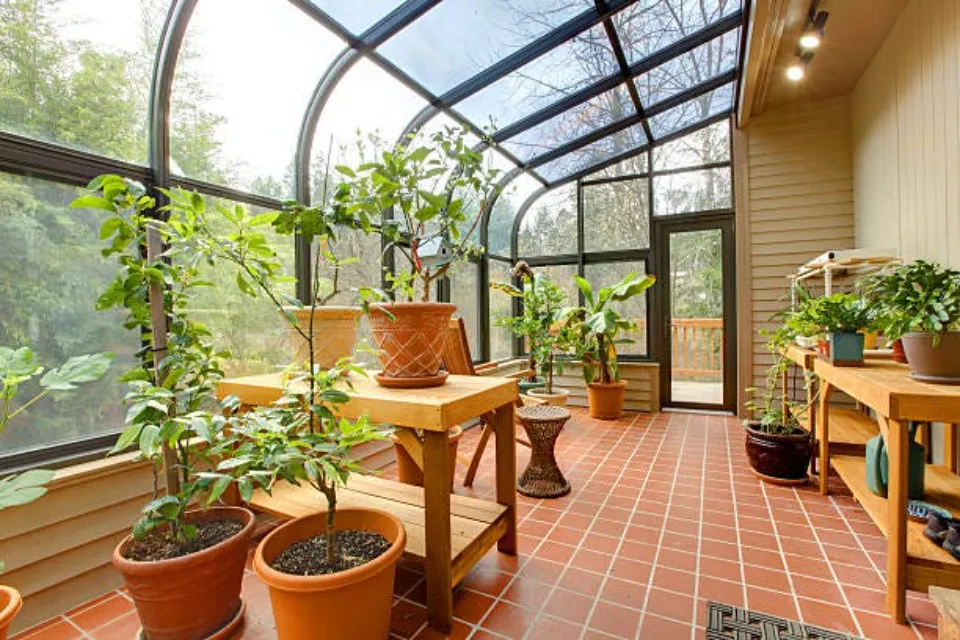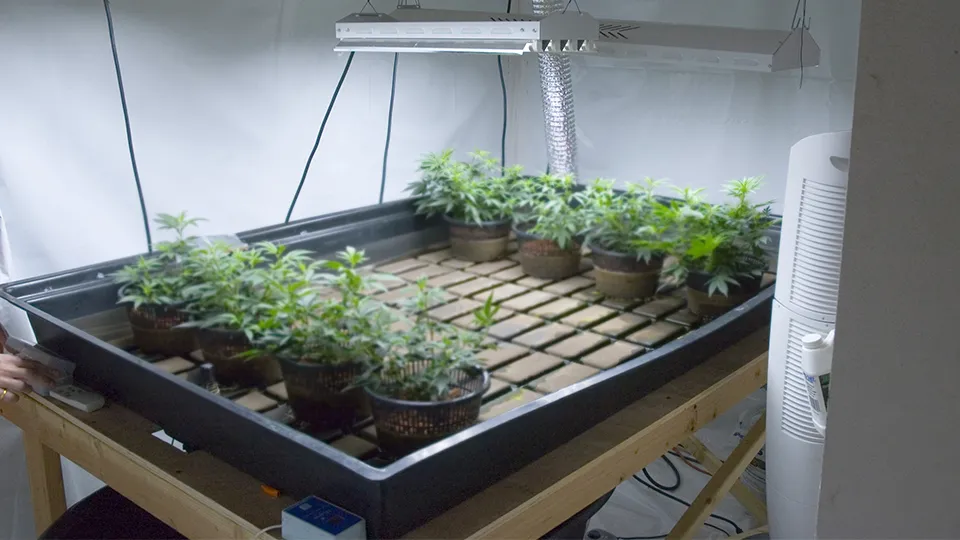Greenhouse gardening involves a lot more than just building a shed and putting plants in it. For more information on greenhouse gardening, continue reading.
Being able to go green through greenhouse gardening is a useful experience. A greenhouse can be difficult to start and keep up, but with practice and time, you’ll get used to it.
Read on if you’re an enthusiastic home gardener who is interested in greenhouse gardening. You can learn how to effectively manage a greenhouse by using the information provided in this compiled Greenhouse Gardening guide.
Table of Contents
What is Greenhouse Gardening?
Greenhouse gardening means cultivating vegetables or flowering plants in a controlled, enclosed environment that extends the growing season and protects against pests.
Fruits, vegetables, and grains are grown in sizable facilities on an industrial scale. Even a 60-acre greenhouse in Kentucky makes millions of tomatoes every year! But installing a greenhouse in your garden area is the typical solution for homeowners.
In order to regulate the growth of the plants inside, a greenhouse creates a climate that is distinct from the outside environment. Plant cultivation involves much more than just a plastic or glass tent.
How Does a Greenhouse Work?

Built from plastic, plexiglass or glass, a basic greenhouse turns sunlight into heat while protecting plants from pests, disease and weather extremes. The gardener cultivates the ideal environment for their plants in a greenhouse. They can experiment with various soils and fertilizers and adjust the temperature, humidity, and shade as necessary.
Greenhouses can be used to overwinter tropical plants, shorten or lengthen the gardening season, grow a variety of plants from climates other than your own, grow edible plants and herbs, start seedlings or transplants for an outdoor garden, and grow edible plants and herbs.
Greenhouse gardening also means you can garden on a rainy or even snowy day, and potentially harvest homegrown fruits and vegetables year-round.
The exacting control of the environment can help grow a huge range of plants beyond what is possible in your climate.
Related Post: How Does A Greenhouse Work?
Types of Greenhouses
There are many different greenhouse types, with shapes suitable for different plant types and intricate or simple designs. Here are a few things they have in common:
- Framing: Most greenhouses are constructed of sturdy yet lightweight frames that can withstand typical weather conditions and wear and tear. Typically, frames are made of PVC pipe, metal, or wood. Wood is the strongest and wind-damage-resistant material to use when designing and constructing a greenhouse (more on that below). To stop dry rot, you must keep the wood sealed. You must also regularly check for termite infestation.
- Material: Transparent or semi-transparent materials, such as glass, polycarbonate, acrylic, or fiberglass, are used to insulate greenhouse walls and roofs.
- Foundation: An impermeable substance that keeps out water and insects and can anchor the walls should be used for this. Among the best materials are wood and poured concrete. Metal floors might be included with pre-built greenhouse kits. Spreading gravel over a porous ground cover that keeps weeds at bay but permits drainage is a cost-effective solution.
Your greenhouse can either stand alone or be fixed to a building’s exterior wall, such as the wall at the back of your home or the wall of your garage. Lean-to greenhouses are what they are known as.
What to Consider When Greenhouse Gardening
Greenhouse gardening is rarely as simple as tossing up a structure and bringing in plants. “In most climates,” says Hachadourian, “a greenhouse will require electricity, water, and heat sources, especially if the plants that you cultivate require heat to survive cold winters.”
In a glass or plastic room, creating heat is typically the simple part. How you manage the environment depends on the equipment you install. Some things to consider:
- Commitment: How devoted are you to greenhouse gardening’s year-round tasks? One major difference between seasonal and greenhouse gardening, Hachadourian says, “is that The gardener is now in charge of providing the plants inside a greenhouse with financial support, financial care, and water instead of Mother Nature!”
- Space and permits: Can you dedicate a certain amount of backyard space to a greenhouse? Keep in mind that as you expand, you’ll need more equipment, including shelving, heaters, and watering systems. Installing a greenhouse might require a local permit, particularly if it’s a permanent structure.
- Types of plants: “Whether you are growing tropical plants or vegetables,” says Hachadourian, “the greenhouse design and settings will be determined by the type of plants you wish to cultivate.”
- Heat: It’s great if you can count on the sun to warm your garden all year long. In order to keep your plants’ temperatures at a healthy level, you’ll need to install one or more heaters. You’ll need an automated heating system to regulate the temperature on a predetermined schedule unless you want to manually turn them on and off as needed (and run the risk of forgetting to do either).
- Air circulation: Your plants will succumb to extreme heat and disease if air cannot circulate in your greenhouse. That entails either manually opening and closing windows or vents as needed, or timing automatic vents.
- Water and humidity: You’ll require a system for watering your greenhouse plants. It could be as easy as dragging in a hose. Additionally, you might want to put in an overhead sprinkler system, an irrigation system, or a spigot.
Keep in mind that despite their benefits, greenhouses are still not completely self-sufficient. For their ultimate success, they need to make investments in time, space, and technology.
The benefits of seeing the plants flourish and grow in ways that they could not without a greenhouse can be fantastic for those who are willing to invest.
Common Greenhouse Gardening Mistakes
It takes a little bit of self-assurance and skill to actually care for plants in a greenhouse. It might take some practice in advance to avoid making one of these typical greenhouse gardening errors. Here are a few things to be on the lookout for.
Temperature
One of the major mistakes novice gardeners make is failing to regularly check the temperature in their greenhouse. Use a simple thermometer or invest in a digital thermometer with the corresponding humidity reading, which is essential to know in order to prevent heat loss.
Humidity
Mold, mildew, and insects could proliferate unchecked in your greenhouse if the humidity is too high. Your plants will become desiccated if you give them too little. To increase humidity, misting is the best method.
Ventilation
Your plants could perish if your greenhouse has poor or no ventilation. To release the warm air, use the roof vents. Alternatively, there may be times when a tiny fan is needed to maintain adequate air circulation.
Soil
Although soil management is crucial, there are still some difficulties involved. In addition to the fundamentals of occasionally combining compost and fertilizer, consider applying a blended soil mixture when setting up your bases. Applying used potting soil will expose you to pests and disease.
Trees
Tree roots from nearby properties may invade your plants from below, consuming moisture and nutrients meant for your greenhouse plants. Branches or leaves can also be dumped at any time of year. Another constant hindrance to limiting light is shades. Avoid positioning your greenhouse close to trees or in a similar way to protect your structure and plants.
How Much Does It Cost to Install a Greenhouse?
The cost of greenhouses varies greatly, or maybe it just varies greatly in the backyard! For less than $100, home improvement stores offer small, lightweight, self-assembled greenhouses. Up to a deluxe kit that costs more than $16,000, prices increase to a few thousand dollars for more substantial models.
Price per square foot for a do-it-yourself greenhouse typically ranges from $10 to $20. Material quality, greenhouse volume, and raw materials market fluctuations all play a role in this.
We found kits at Greenhouse Megastore for about $21 per square foot (for a 6 ft. x 8 ft. polycarbonate greenhouse with no base), $48 per sq. ft. for a 94-sq.-ft. foot model with a galvanized steel base, and even $41,000 for a nearly 300-sq.ft. model. (That equals $143 per square foot, in case you were wondering.)
Professionally built greenhouses also come in a wide range. You can be sure that a basic model will cost you at least a few thousand dollars.
Final Words on Greenhouse Gardening
Greenhouse gardening is a great way to start gardening or extend your growing season. You can cultivate the best conditions for your plants’ growth and flourishing by engaging in this type of gardening.
Growing in a greenhouse can be so much fun for beginners and experienced gardeners alike but before you pick the plants you fancy to grow,examine and research what conditions, temperatures, and moisture your plants will requireto flourish.
This is an essential step for the success of your plans.
Read More: DIY Indoor Greenhouse
FAQs
What is the Easiest Thing to Grow in a Greenhouse?
Lettuce, tomatoes, peppers, cucumbers, and zucchini.
What Should You Not Put in a Greenhouse?
For a greenhouse, filling containers with common garden soil would be a disaster.
Should a Greenhouse Be in Full Sun?
It’s essential to place a greenhouse in the sun to maximize light exposure for the growing plants. Shade cloths can be used to cover the windows if less light is required.

















